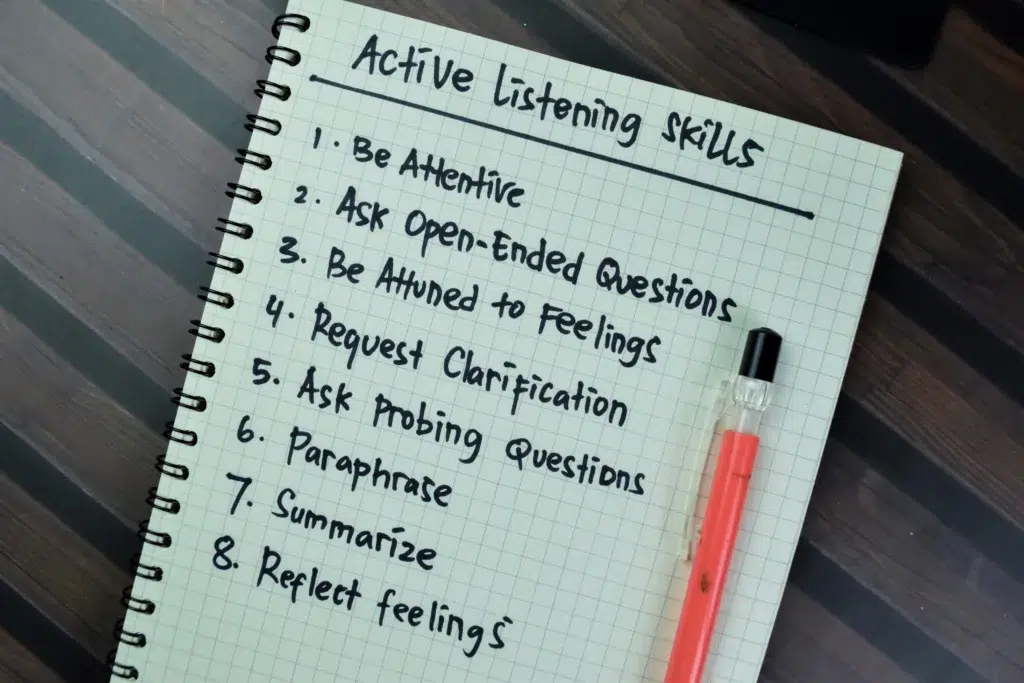Active listening is a fundamental communications skill that involves fully engaging with someone or a group of people by paying close attention to both their verbal and nonverbal cues. It goes beyond simply hearing words. Active listening requires concentration, understanding, and empathy. This skill is essential in various contexts, including personal relationships, professional environments, counseling sessions, and everyday interactions, and it is an extremely important skill for public information officers (PIOs).
Active listening not only fosters better understanding and connection between individuals but also promotes effective problem-solving and conflict resolution. It is particularly crucial for PIOs due to the nature of their role, which involves disseminating information to the public and serving as a liaison between an organization or government agency and the community. The role of a PIO also involves listening to those who may have strong opinions or who may disagree strongly with the actions of your agency — police, fire, public health, government, etc. In an upcoming training class at JGPR Academy, we will spend significant time discussing active listening and working with those with opposing viewpoints. There are significant training resources available on these subjects, including several LinkedIn courses on opposing viewpoints. For now, here are the basics!
One of the key elements of active listening is giving undivided attention to the speaker. This means eliminating distractions and focusing solely on what the speaker is saying. It involves maintaining eye contact, facing the speaker directly, and nodding or using other gestures to indicate understanding and encouragement. By demonstrating attentiveness, the listener conveys respect and creates a conducive environment for meaningful communication.
Another crucial aspect of active listening is providing feedback to the speaker to demonstrate understanding and encourage further expression. This feedback can take various forms, including paraphrasing, summarizing, and asking clarifying questions. Paraphrasing involves restating the speaker’s words in one’s own words to confirm comprehension and show empathy. Summarizing involves synthesizing the main points of the speaker’s message to ensure mutual understanding. Asking clarifying questions helps clarify any ambiguity or confusion and encourages the speaker to elaborate on their thoughts and feelings.
Furthermore, active listening entails suspending judgment and refraining from interrupting the speaker. It involves approaching the conversation with an open mind and withholding criticism or evaluation until the speaker has fully expressed themselves. By refraining from premature judgment, the listener creates a safe space for the speaker to share their thoughts and emotions without fear of being criticized or dismissed. This fosters trust and openness in the relationship, facilitating more meaningful and honest communication.
Empathy is another crucial component of active listening. Empathy involves understanding and sharing the feelings of another person. It requires the listener to put themselves in the speaker’s shoes and genuinely try to understand their perspective. Demonstrating empathy can be as simple as acknowledging the speaker’s emotions and expressing understanding and compassion. By validating the speaker’s feelings, the listener fosters a sense of connection and support, which encourages further disclosure and communication.
Active listening also involves paying attention to the speaker’s nonverbal cues, such as facial expressions, body language, and tone of voice. Nonverbal cues often convey additional information about the speaker’s emotions and intentions that may not be expressed verbally. By observing and interpreting these cues, the listener gains a more comprehensive understanding of the speaker’s message and can respond accordingly. For example, a speaker’s hesitant tone or fidgeting may indicate underlying uncertainty or discomfort, prompting the listener to offer reassurance or further exploration of the topic.
When working with those with diverging or sharply opposing viewpoints, we teach the Both/And approach. Top government agencies, including the International Atomic Energy Agency teach their officials how to work with — how to engage with, talk to, and ultimately work with — those with disagreeing viewpoints and how to overcome rumors.
Here’s why listening, including listening to those who disagree with you, can be helpful to PIOs:

- Understanding Public Concerns: PIOs need to be attuned to the concerns, needs, and sentiments of the community they serve. By actively listening to the public, PIOs can gain insights into the issues that matter most to the community members. This understanding allows them to tailor their communications effectively, addressing specific concerns and fostering trust and credibility. Active listening turns a PIO’s workday into an instant focus group measurable.
- Building Trust and Credibility: Effective communication is essential for building trust and credibility with the public. Active listening demonstrates to the community that their voices are heard and valued. When PIOs actively listen to the concerns and feedback of community members, they are better equipped to respond thoughtfully and with empathy, thereby strengthening trust and credibility in their communications.
- Managing Crisis Situations: During crisis situations, such as natural disasters, accidents, or public health emergencies, effective communication is paramount. PIOs play a critical role in disseminating timely and accurate information to the public to ensure their safety and well-being. Active listening enables PIOs to gather real-time feedback from the community, identify misinformation or rumors, and address concerns promptly, thereby helping to manage crises more effectively.
- Enhancing Public Engagement: Active listening is essential for promoting meaningful public engagement and participation. By soliciting feedback, ideas, and input from the community, PIOs can involve residents in decision-making processes, policy development, and community initiatives. This inclusive approach not only fosters a sense of ownership and empowerment among community members but also leads to more effective and sustainable solutions to public challenges.
- Anticipating Public Reactions: PIOs need to anticipate how the public will react to various announcements, policies, or initiatives. Active listening allows PIOs to gauge public sentiment, identify potential areas of controversy or opposition, and tailor their communication strategies accordingly. By proactively addressing concerns and engaging with stakeholders, PIOs can mitigate potential backlash or misunderstandings and promote a more positive reception of their messages.
- Strengthening Relationships with Stakeholders: Effective communication is essential for building and maintaining strong relationships with stakeholders, including community leaders, organizations, elected officials, and the media. Active listening enables PIOs to understand the perspectives and priorities of various stakeholders, identify common ground, and foster collaboration and consensus-building. By engaging in meaningful dialogue and demonstrating empathy and respect, PIOs can cultivate positive relationships that support their communication efforts and organizational goals.
For more, register for our live classes today!
